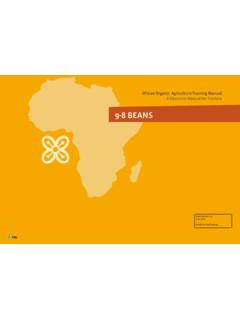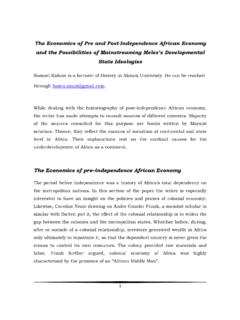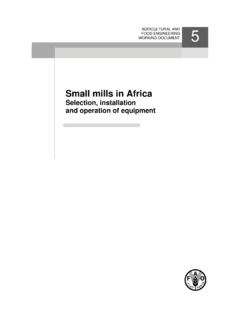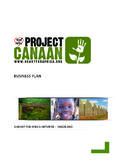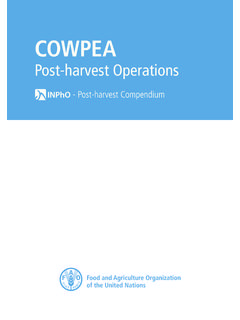Transcription of 1 SOCIAL SCIENCES & GEOGRAPHY - Good Schools Report
1 SOCIAL SCIENCES & GEOGRAPHY - EDUCATOR RESOURCE | 1 SOCIALSCIENCES& GEOGRAPHYGRADE 4 Educator rEsourcE SOCIAL SCIENCES & GEOGRAPHY - EDUCATOR RESOURCE | 3 Dear Educators,It is now ten years since we introduced our Woolworths Making the Difference Educational Programme for primary Schools . We re pleased to say that this programme is now used in over 2 000 Schools around the country, and, through its resource material, interactive classroom activities and teacher training, continues to make a valuable contribution to the education and skills development of South Africa s young the past few years, it has become evident that there is a need to extend both the scope and the reach of the programme. While Healthy Living and the Environment remain the focus, the content has now been revised and expanded and the target group broadened to include the entire Intermediate Phase of Grades 4, 5 and 6. The programme now includes three educator resources: Life Skills for Grades 4 and 5, SOCIAL SCIENCES ( GEOGRAPHY ) for Grade 4, and Natural SCIENCES and Technology for Grade 6.
2 Like the previous modules, the three new resources have been developed in collaboration with the Western Cape Education Department. All the material is curriculum based and designed to meet the requirements of the new Curriculum and Assessment Policy Statement (CAPS) introduced in January 2013. New material, including valuable case studies from Woolworths, has been added to supplement the curriculum. Theoretical content and experiential learning activities are now more closely linked, with worksheets and posters that complement experiential learning activities now incorporated into the resource creation of these new resources would not have been possible without the commitment and contribution of the Western Cape Education Department, the Marine Stewardship Council, the Woolworths Good Business Journey team and our in-house and consulting dietitians. We would like to take this opportunity to thank them for their assistance and for their ongoing support. Healthy living and caring for the environment are both very close to our hearts at Woolworths.
3 We hope that this 2nd edition of The Making the Difference Programme will help your learners gain an understanding of the importance of both to their futures and the future of our country. Kind regards,Pieter TwineGeneral Manager: MySchool & Loyalty4 | SOCIAL SCIENCES & GEOGRAPHY - EDUCATOR RESOURCECONTACT DETAI LS:WESTERN CAPE & EASTERN CAPE REGIONSS adia de VriesEmail: 083 379 2868 Fax: 021 447 6480 GAuTENG REGIONT hando TladiEmail: 083 277 3875 Fax: 086 216 0633 KWAZuLu NATAL REGIONJ ackie HardienEmail: 071 888 2661 Fax: 031 569 2242 SOCIAL SCIENCES & GEOGRAPHY - EDUCATOR RESOURCE | 5 SECTION 1:Food and Farming in South Africa Term 3 OVERVIEWOF MODuLE:Ways of farmingThe welfare of farm animals710151925 Identifying plant, animal and human needs for waterThe Water CycleSaving and protecting waterSECTION 2:Water in South Africa Term 4 SOCIAL SCIENCES & GEOGRAPHY - EDUCATOR RESOURCE | 7 TOPIC: FOOD AND FARMING IN SOuTH AFRICACONTENT AND CONCEPTS: WAYS OF FARMING.
4 CROP AND STOCK FARMINGTERM 3 INFORMATION FOR EDuCATORS: During Term 3, under the topic Food and Farming in South Africa, CAPS requires you to teach learners about the Ways of Farming (page 23). The following content for educators is aligned to CAPS. This section includes information for educators, suggested lessons, a reading activity as required by CAPS, several classroom activities and flash OF FARMING Producing a smaller quantity of food Vulnerability to bad weather conditions Vulnerability to pests and diseases Vulnerability to food insecurityLESSON 1:WAYS OF FARMING TO DO: Present the following content to learners:SubSISTENCE FARMINGF arming for your family and yourself is called subsistence farming. Subsistence farming usually includes producing small amounts of a variety of crops such as maize, pumpkins, beans, cabbage, spinach, madumbes and marog. It often includes keeping stock as well, such as chickens, goats, cattle, sheep, pigs, turkeys and ducks. The advantages of subsistence farming include: The main disadvantages of subsistence farming include: COMMERCIAL FARMINGF arming as a business is called commercial farming.
5 There are many different ways to farm commercially. Different ways of commercial farming have different impacts on the environment. Conventional commercial farming usually focuses on producing just one type of crop, such as maize or bananas; or one type of animal product, such as beef or dairy. This is called monoculture. It is intensive farming which means that farmer keeps the maximum number of animals possible or grows the maximum number of crops possible. Saving the family money because they don t have to buy all their food Producing a variety of fresh vegetables, fruit and animal products that do not have to be transported or packaged When possible selling surplus produce and gaining extra income More environmentally friendly; farming without the use of pesticides, herbicides and chemical fertilisers Less impact on biodiversity as indigenous plants and animals are part of the environment8 | SOCIAL SCIENCES & GEOGRAPHY - EDUCATOR RESOURCEThe main disadvantages of commercial farming include.
6 Monoculture on a farm destroys and replaces the natural ecosystem which would have included many different species of plants and animals Monocultures and the lack of biodiversity on the land can cause infestations of pests, weeds and diseases that adversely affect crops Conventional commercial farmers have to use many pesticides and herbicides to protect their crops because there are no natural predators in their unbalanced farm ecosystem Conventional commercial farmers have to use large quantities of chemical fertilisers for their crops to grow Conventional commercial farmers use substances such as growth hormones to make their animals grow bigger more quickly and routine antibiotics to keep their animals healthier Pesticides, herbicides and chemical fertilisers pollute land and water Of all our industries, commercial farming uses the most fresh water in South AfricaREAD OuT LOuD: Farming for the Future Woolworths Case StudyTEACHER NOTE: You can read the following short story out loud to your learners to inform them that there are better ways to farm.
7 Discuss the story with them afterwards. Do learners think that Farming for the Future is a good idea? If so, why? If not, why? What long-term advantages are there to Farming for the Future? Do learners think that consumers can play a role in a solution like this? If so, what positive impact can consumers make?Informal assessment: Guiding the class discussionThe main advantage of commercial farming is that a large quantity of affordable food canbe OUR FRESH PRODUCE SUPPLIERS ARE PART OF OUR FARMING FOR THE FUTURE PROGRAMME, FARMING IN HARMONY WITH YOu SOCIAL SCIENCES & GEOGRAPHY - EDUCATOR RESOURCE | 9 WOOLWORTHS CASE STuDYFARMING FOR THE FuTuRE My name is Themba, and I love being out on our farm with my dad. We grow vegetables and herbs for Woolworths, and I m proud of my dad because he is Farming for the Future . That means we look at our whole farm as an ecosystem where we use the best practices of conventional and organic farming to grow good quality food in a responsible way.
8 Farming for the Future is part of the Woolworths Good Business Journey that helps farmers produce food in more sustainable you farm for the future, you start with healthy, balanced soil that supports plenty of micro-life and contains lots of good minerals that our crops need to grow well. We use lots of compost and worm droppings to build the fertility of our soils so that there s less need for artificial fertilisers. Everything is interconnected because we have healthy soil and healthy plants, we have fewer problems with pests. Often we can use clever, nature-friendly ways to control pests so that we use less of the great things about Farming for the Future is that we save water. This is important, because water is a scarce resource in South Africa and agriculture uses up to 80% of the available fresh water. On some Farming for the Future farms, water usage has been cut by 30% by using scientific methods to work out how much water the crops actually need, then watering using a drip irrigation system so that there s no water being wasted.
9 We also manage our waste water properly to ensure that we don t pollute the river that runs through our farm. Because my dad has created a healthier, sustainable farm environment, we have lots of biodiversity on our farm. There are plenty of indigenous plants and trees so that lots of birds, mammals, insects, reptiles and frogs canlive on our farm again. The best thing about my dad farming sustainably is that when I grow up and start farming too, there will still be healthy soil, enough clean water and lots of biodiversity for me, my childrenand my | SOCIAL SCIENCES & GEOGRAPHY - EDUCATOR RESOURCE Which farm or farms would you like to buy your food from? Why? Which farm looks like a healthy environment? Why?TO DO: Make a copy of the following worksheet for each learner and ask them to complete it individually. Guide a class discussion when they have finished.(Refer to worksheet 1 on pages 27-29.)(The worksheet can be used as an informal assessment.)Informal assessment: Guiding the class discussionLESSON 2:THE WELFARE OF FARM ANIMALS TO DO: Present the following content to learners:THE WELFARE OF FARM ANIMALS Many people believe that it is important to treat farm animals well and that they should live a good life.
10 This is known as caring about animal welfare. Conventional farming of animal products including milk, eggs, chicken, beef, pork and lamb involves keeping as many animals as possible in the production facilities. The animals are kept in cages or in pens so that they take up as little space as possible and can be more easily managed. It is often called factory farming because these animal production facilities do not look like farms where animals roam in fields. Most animals in these production facilities spend their whole lives caged or penned, and never go outside in the DO: Show your learners the following flash cards. (Refer to flash cards on opposite page.)Informal assessment: Guiding the class discussion If you were a chicken that laid eggs, which farm would you like to live on? Why? Which farm looks like a healthy environment? Why? Do you think caring for animal welfare is important? Why Which farm would you like to buy your eggs from? SOCIAL SCIENCES & GEOGRAPHY - EDUCATOR RESOURCE | 11 CONVENTIONAL EGG FARMING FREE RANGE EGG FARMING FLASH CARD 1:FLASH CARD 2:12 | SOCIAL SCIENCES & GEOGRAPHY - EDUCATOR RESOURCEWOOLWORTHS CASE STuDYFREE RANGEFREE RANGE: What does it mean?


